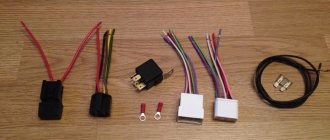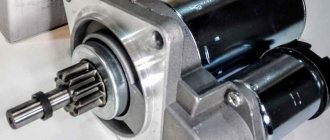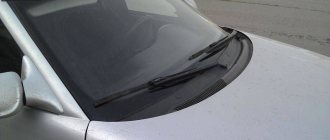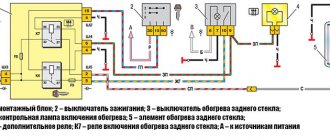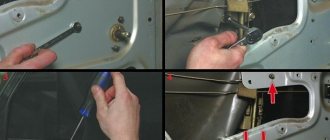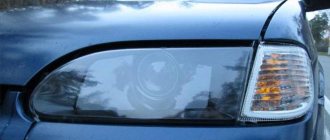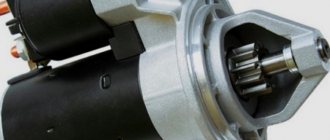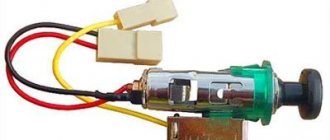The car owner doesn’t really think about how windshield wipers work, or what they are called wipers until they begin to fail for various reasons. Wipers are an important element of driver safety; road visibility in rainy weather and snowfall depends on their operation. To understand what factors affect the operation of the blades, you need to familiarize yourself with the diagram of the VAZ 2114 windshield wipers. The reader will learn from this article how glass wipers work and what problems car owners encounter.
Why the wipers don't work
In this article, we will analyze the main possible malfunctions of wipers and find ways to solve the problem.
The windshield wiper is a very important element of the car, due to its malfunction, movement is prohibited, according to traffic regulations, and in general, it is life-threatening.
It is worth noting that the mechanism is designed for a long service life. Therefore, malfunctions usually arise due to improper operation. It is also worth taking into account that most breakdowns of the glass cleaning system occur in the winter.
This is probably the most basic mistake of all car enthusiasts; many will remember themselves “in their youth.”
It’s winter, I get into the car, start it, turn on the wipers, they jerk a little and that’s it. In this case, the breakdown could have occurred either electrically (for example, a fuse in the electric motor) or mechanically (the motor itself), and it occurred due to the fact that the blades froze and stuck to the windshield.
Rear door glass cleaner VAZ 2114, connection diagram
On VAZ 2114, 2113 cars, a rear door glass cleaner (rear wiper) is installed, consisting of an electric motor (gearmotor) and a brush with a leash.
Here is an electrical diagram of its connection with a description of the elements and operating order (turning the purifier on and off).
Glass cleaner for the rear door (trunk door) of a VAZ 2114, 2113 car. connection diagram
Description of the rear wiper connection diagram
— In the electrical circuit for connecting the electric motor of the trunk door glass wiper (rear wiper) on VAZ 2114, 2113 cars, voltage is supplied from the “B+” terminal of the generator. Through the ignition switch, after turning the key to position “I”.
— The cleaner’s electric motor is double-brush, excited by permanent magnets, with a built-in thermobimetallic fuse, which breaks the electrical circuit in case of overload.
— The cleaner is turned on by moving the lever of the right steering column switch away from you to the last fixed position. If you press further into the very last, non-locking position, the washer motor will turn on and washer fluid will flow onto the rear window from the upper nozzle, facilitating the work of the brushes. When you release the lever, the washer immediately turns off.
Notes and additions
— On VAZ 2108, 2109, 21099 cars with mounting block 17.3722, a time relay was included in the electrical circuit for switching on the washer motor, which allows you to continue washing the rear window for another five seconds after releasing the lever from the extreme non-locking position.
— The electrical circuit of the tailgate glass wiper is protected by fuse F7 (30A) in the mounting block.
Source
Relays and fuses VAZ 2114
F1 for 10 Amps (A) rear fog lights and rear fog light warning lamp. F2 for 10 A turn signal lamps, turn signal relay, hazard lights, hazard warning lights. F3 7.5 A lamps for interior lighting (both) and trunk, ignition lighting, powertrain control system control lamp, brake lamps, computer, if available. F4 20 A carrier, relay and rear window heating element. F5 20 A horn and its relay, cooling fan. F6 30 A power windows and their relays F7 30 A motor heater, headlight cleaner, windshield washer, cigarette lighter, glove compartment light bulb, rear window heating relay winding. F8 7.5 A right fog lamp. F9 7.5 A left fog lamp. F10 at 7.5 A left side marker, lamp signaling the inclusion of the side light, lamps for illuminating the sign, engine compartment, illumination of switches and instruments, instrument lighting switch. F11 at 7.5 A right side. F12 at 7.5 A right low beam. F13 at 7.5 A left low beam. F14 for 7.5 A left high beam and a light indicating that the high beam headlights are on. F15 at 7.5 A right far. F16 30 A - a light indicating insufficient oil pressure, brake fluid level, engagement of the parking brake, low battery, instrument cluster, relay for monitoring the health of lamps, indication of control systems, reversing lamps, turn indicators and their relays, as well as an alarm if turning mode is turned on, computer, generator excitation winding is turned on at the moment the engine starts.
Connection diagram for wipers via relay VAZ 2114
VAZ 2113, 2114, 2115 cars considered
Attention! The location of fuses and relays in the blocks may differ depending on the year of manufacture and vehicle equipment. You can see earlier modifications of fuse blocks on this page.
Fuses for the VAZ 2114 injector and VAZ 2115 injector are also described on this page.
Where are the fuses and relays located?
The main part of the fuses and relays is located in the mounting block of the engine compartment.
To get to the block you need to press two latches and remove the cover
Using pliers installed in the block, remove the fuses
On the inside of the cover there is a diagram of the location of fuses and relays.
Click on the image to enlarge.
Fuse mounting block 2114-3722010-60
Many have encountered such a slight inconvenience in the operation of the standard windshield wiper of the VAZ 2109: when the windshield washer is turned on for a short time, the blades make 3 strokes, although the last stroke of the brush is already made on dry glass, and two strokes would be enough to remove all the water that was splashed washer.
This inconvenience, as it turns out, can be easily eliminated. To do this, we buy a new windshield wiper relay (if something doesn’t work out, you can insert the old one and thus not be left without wipers) type 526.3747, or another similar one - the markings may differ depending on the relay manufacturer. In the circuit of this relay, you need to replace resistor R4. The standard one has a nominal value of 130 kOhm, we need to set it smaller, within the range of 40 kOhm - 70 kOhm. I have 56 kOhm. You can find one at points selling radio components, it costs a penny, or you can remove it from old equipment.
Relay location in the black box
VAZ 2109 wiper relay diagram
The internal design of such a relay can be different:
In all cases, the resistor we need is connected to the 4th leg of the microchip. It is highlighted in the pictures above.
By the way, this modification is also relevant for VAZ 2114-2115, VAZ 2110, Lada Kalina, Lada Granta - for all models where this type of relay is used.
New relays may have a fundamentally different design. For example, I came across this relay marked 723.3777 from the Energomash plant:
Relay 723.3777 Energomash. We can't change it
We cannot remake such a relay, so we can leave it as a spare (original), and we will solder the original one, removed from the mounting block:
We figured out the number of brush strokes. Now one more thing.
When you first press the lever to wash the glass, it usually happens like this: the brushes have already started moving, but there is no water on the glass yet. This is due to the fact that the pump needs time to drive water through the tubes from the reservoir to the washer nozzle. This situation can be corrected by installing a check valve in the tube to prevent water from flowing from the tubes back into the tank when the pump is not running. Personally, this point doesn’t bother me much, since the brushes run dry only the first time they are turned on, and installing a check valve increases the resistance to water flow in the pipes of the already weak washer pump, so I have not done such a modification on my car and do not plan to.
Car electrical equipment
1 — headlight block; 2 — gearmotors for headlight cleaners*; 3 — fog lights*; 4 — ambient temperature sensor; 5 — sound signals; 6 — engine compartment lamp switch; 7 — electric motor of the cooling system fan; 8 — VAZ 2114 generator; 9 — low oil level indicator sensor; 10 — washer fluid level sensor; 11 — front brake pad wear sensor; 12 — wire tips connected to the common windshield washer pump**; 13 — windshield washer pump; 14 — headlight washer pump*; 15 — wire ends for connecting to the rear window washer pump on VAZ 2113 and VAZ 2114 cars; 16 — low oil pressure indicator sensor; 17 — engine compartment lighting lamp; 18 — wire lug for connection to the wiring harness of the engine management system or to the wiring harness of the ignition system on carburetor vehicles; 19 — windshield wiper gearmotor; 20 — VAZ-2114 starter; 22 — coolant temperature indicator sensor; 23 — reversing light switch; 24 — low brake fluid level indicator sensor; 25 - battery; 26 — sensor for insufficient coolant level indicator; 27 — relay for turning on fog lights; 28 — mounting block; 29 — brake light switch; 30 — plug socket for a portable lamp; 31 — lamp for illuminating the headlight hydrocorrector scale; 32 — parking brake warning lamp switch; 33 — backlight lamp connection block; 34 — switch for instrument lighting lamps; 35 — steering column switch; 36 — alarm switch; 37 — front seat heating element relay; 38 — ignition switch VAZ 2114; 39 — rear fog light circuit fuse; 40 — fuse for the front seat heating elements circuit; 41 - door lock circuit fuse; 42 — front ashtray illumination lamp; 43 — ignition relay VAZ-2114; 44 — cigarette lighter; 45 — glove box lighting lamp; 46 — glove compartment lighting switch; 47 — heater fan electric motor; 48 — additional resistor of the heater electric motor; 49 — heater fan switch; 50 — heater switch backlight; 51 — lamp for illuminating the heater levers; 52 — gear motors for electric windows of the front doors; 53 — right front door power window switch (located in the right door); 54 — gearmotors for locking front door locks; 55 — wires for connecting to the right front speaker; 56 — gearmotors for locking rear doors; 57 — wires for connecting to the right rear speaker; 58 — door lock control unit; 59 — wires for connecting to radio equipment; 60 — headlight cleaner switch; 61 — rear window heating element switch; 62 — relay for turning on rear fog lights; 63 — block for connection to the heating element of the right front seat; 64 — switch for rear fog lights: 65 — switch for the heating element of the right front seat; 66 — fog lamp switch; 67 — switch for external lighting lamps; 68 — left front seat heating element switch; 69 — block for connection to the heating element of the left front seat; 70 — wires for connecting to the left front speaker; 71 — left front door power window switch; 72 — right front door power window switch; 73 — wires for connecting to the left rear speaker; 74 — side direction indicators: 75 — lamp switch on the front door pillars; 76 — lamp switch on the rear door pillars; 77 — lampshade; 78 — canopy for individual interior lighting; 79 — block for connecting to the wiring harness of the VAZ 2114 electric fuel pump; 80 — trunk light switch; 81 — instrument cluster: 82 — trunk lighting lamp; 83 — display unit of the on-board control system; 84 — trip computer (not in all models); 85 — block for connecting the wiring harness of the engine control system; 86 — rear external lights of the VAZ-2114; 87 — rear internal lights; 88 — block for connection to the rear window heating element; 89 — license plate lights; 90 - additional brake signal located in the spoiler.
In the instrument panel wiring harness, the second ends of the white wires are brought together into one point, which is connected to the instrument lighting switch (except for the white wire, from plug “4” of block “X2” of mounting block 28 to display block 83 of the on-board control system). The second ends of the black wires are also brought together to points connected to ground. The second ends of the yellow wires with a blue stripe are brought together to a point connected to plug “4” of the “X1” block of the mounting block. The second ends of the white wires with a red stripe are brought together to a point connected to plug “10” of the “X4” block of the mounting block. And the second ends of the orange wires are also brought together to a point connected to plug “3” of the “X4” block.
VAZ windshield wiper does not work: causes of malfunction
The operating mechanism of windshield wipers is designed for a long service life and, as a rule, malfunctions and breakdowns occur due to improper operation. Most often, the failure of their wipers happens in winter, when the windshield wiper blades freeze to the windshield, and the driver, without noticing this, turns on the electric motor. In this case, both the electrical and mechanical parts of the windshield wiper may fail. In this article we will analyze the nuances when troubleshooting and repairing windshield wipers on VAZ cars.
How the windshield wiper works
On VAZ 2108, 2109, 2113, 2114 (hatchback body) cars a windshield wiper and rear window washer are installed. On VAZ 2199, 2115 (sedan) models there is no rear window wiper.
Electrical diagram of the rear wiper:
Windshield wipers have several operating modes: intermittent (work with a pause), low (first) speed, high (second) speed, one-time triple cleaning of the glass, operating mode with a windshield washer. The rear wiper operates only in one position and in conjunction with the rear window washer.
Typical windshield wiper malfunctions and methods for eliminating them:
Windshield wiper malfunctions include:
1) Complete inoperability of the system (not a single mode works, the electric motor cannot be heard):
- check the presence of voltage of 12 volts at terminal 6, in the windshield wiper connector, ground 4, and also check all supply circuits (fuses 4 and 5, switch, mounting block, ignition switch, etc.);
- check the operation of the mode switch (presence of 12 V control voltage at terminals 1 and 2 of the windshield wiper connector when switching modes);
- check the functionality of the electric motor itself (dismantling and disassembly is required);
2) Intermittent mode does not work (all others work);
- the main reason is a non-working “short circuit” relay, in the diagram, and a mode switch (the easiest way to check is by substitution, for a known good one)
3) The windshield wiper blades do not stop in the down position, but stop anywhere (the blades can extend beyond the windshield):
- the limit switch in the electric motor is broken (or burnt out) (it is not possible to replace it, only the entire motor, but you can try to fix and repair the switch);
- incorrect adjustment of the position of the wipers (align the wipers in place);
- the drive shaft of the brush mechanism began to be dismantled (disassembly and replacement of failed parts);
4) The noise of the electric motor is heard, but the brushes do not move (the brushes may twitch in one place):
- the drive shaft of the windshield wiper mechanism has been damaged (“licked off” the splines) (replace or fix the splined part of the electric motor);
- the nut securing the mechanism rod to the electric motor shaft has become loose (tighten the nut);
5) The wipers do not operate after turning on the windshield washer:
- Most likely, the steering column mode switch has failed (replace with a known good one);
- there may be a malfunction in the operation and serviceability of the mounting block (measure the voltage at terminals 9 and 18);
6) Poor quality of glass cleaning.
- The windshield wiper blades have lost their elasticity (replace the blades with new ones);
- contact with oily materials on the glass (oil from the exhaust pipe of a car in front, waxing at a car wash, contamination after polishing, etc.)
Troubleshooting and repair of the rear windshield wiper follows similar principles (the diagram is attached below), with the exception of the absence of operating modes in the rear windshield wiper, and accordingly the absence of some parts (relay, limit switch in the electric motor, and so on).
Electrical part of the windshield wiper:
Causes and troubleshooting
Even the old wipers in the VAZ-2114 model are made so well that they can provide long-term stable operation. Of course, if you look after them well and avoid unfavorable situations. There can be many reasons for breakdowns and their manifestations, but there is no need to despair or get confused ahead of time. Sometimes repairing windshield wipers can be quite simple. What could be wrong with the mechanism?
Slow wiper operation indicates that oxidation of metal parts or lack of lubrication is most likely to blame. This often happens in spring or winter. It is recommended to completely remove the trapezoid and lubricate all fasteners, hinges and other rubbing parts with lithol. It is possible to thoroughly clean the hinges from dirt only after complete dismantling. Constant operation of the wipers is the reason for the breakdown of the gear motor. It can be found both inside and outside the case, and replacing it is not difficult, since it is secured with four bolts
When dismantling, be careful not to break the teeth of the new motor with the crank. It is better to fix the position of the crank when removing the motor and disconnect its fasteners. Relay K3 is responsible for intermittent mode
In this case, replacement is necessary. Just in case, we recommend checking the functionality of the new relay as early as possible in order to avoid purchasing a non-working copy or a fake. The second option is that the wiper mode switch is faulty. Then replacement is also required. If the wipers do not return to their original position, several things could be the cause. Firstly, poor installation of wipers. Corrected by recalibration. Secondly, the limit switch is faulty. You can repair it, or better yet, replace the motor completely: if the switch has become unusable, other systems can too. The last reason is the wear of the splines on the drive shaft. Necessary parts should be replaced. If the brushes do not move, but you can hear the motor running, the problem is the wear of the teeth in the drive part of the motor. Corrected by replacing the part. But it is possible that the nut securing the trapezoid to the motor has simply come loose, and then the repair will take seconds. A broken wiper switch may prevent the wipers from operating when the washer is turned on. In this case, the switch should be replaced. Also, washers can stop the brushes from working due to faulty wiring. After checking the voltage at the terminals, you need to find an open circuit or clean the connectors. If the wipers begin to take on a life of their own and turn on themselves, you will need to open the mounting block and check the wiring. Moisture probably got in there. It is necessary to clean the oxidized contacts, it is advisable to prevent further water from entering there. If neither the wipers nor the motor work, the right solution would be to test the motor directly from the battery. Maybe it just ran out of lubricant or the brushes were worn out. You should make sure that 12 V voltage is supplied to the 6th terminal, check the ground on the 4th terminal, the ignition switch, the 4th, 5th fuse and so on. You can also check the mode switch to see if there is control voltage at the 1st and 2nd terminals. If the brushes are not doing their job well, check their condition. Perhaps they have lost elasticity or worn out, then they need to be replaced. Perhaps the reason is their insufficient adherence to the glass, then the wiper arm spring needs to be replaced. Or maybe the glass is simply stained with something greasy and needs a good wash.
If you are not confident in your abilities as a mechanic, it is better to entrust your car to a specialist; a professional approach can be much cheaper than unexpected mistakes.
Wipers are devices used to clean the windshield and rear windows from dirt, dust, moisture and snow that accumulate on them. Very often, driving without them is simply impossible and even dangerous (especially in rainy weather or snowfall). That is why, in the case when the wipers on a VAZ 2114 do not work, the motorist must find the cause of this problem as quickly as possible and eliminate it.
The principle of operation of the device itself is quite simple - long narrow brushes connected by a special lever to an electric gear motor move back and forth across the glass and clean its surface. In order to improve the cleaning properties of the wipers, the glass washer can also be turned on along with them (if necessary).
The wiper blades themselves are replaceable, and in case of damage or severe wear, they can be replaced with similar ones.
On the 14th model, the wipers can operate in several modes at once, which the motorist can choose, namely:
- intermittent mode;
- constant mode at 1st speed;
- constant mode at 2nd speed;
- constant mode synchronously with the washer.
Windshield wiper motor - when repairs are required
Welcome, friends, to the DIY car repair website. Windshield wipers are an indispensable attribute of any car.
Whatever the car is - cheap or expensive, domestic or foreign, passenger or truck, it must have wipers.
The main thing is that they are in good working order and ready to work. In this case, the main element that is responsible for the motor function is the windshield wiper motor.
How does a windshield wiper motor work?
Most cars have two blades that provide more effective cleaning of the windshield. A single wiper is usually mounted on the rear window.
The device operates in two or three modes, which allow the brushes to provide intermittent, slow or fast cleaning.
The overall design includes a wiper motor (a small motor with a gearbox), a brush return mechanism, a lever system and the cleaning rubber bands themselves. In parallel with the cleaner, you can use the windshield washer, which supplies water in the form of a directed jet.
One of the most unreliable elements of the system, which often fails, is the motor. If it breaks down, motorists do not know what to do and what the reasons may be.
Heater diagram, rear window heating
- Mounting block;
- Ignition switch;
- Ignition relay;
- Heater motor switch;
- Additional resistor;
- Heater motor;
- Rear window heating switch with turn-on indicator lamp;
- Rear window heating element; K7 - Relay for turning on the heated rear window
Motor malfunctions and solutions
Let's look at what to do if the windshield wiper motor does not work, and what can cause such problems. There are several options:
1. The electric motor does not work, the bimetallic fuse is inactive, and the fusible insert responsible for powering the wipers is intact. In this case, you need to check the serviceability of the wiring, the quality of connections of all contacts, determine any existing damage and eliminate them.
If everything is fine with the wiring, then you should check the wiper switch. If it acts up, just replace it. The engine itself may not work - this often happens when brushes stick or contact connections burn.
In this case, you need to repair the windshield wiper motor - inspect it, replace faulty elements, and clean dirty components. It is important to check the integrity of the wiring that connects the electric motor and the block.
The next step is to check the bimetallic fuse, which needs to be cleaned, and if repair is impossible, simply discarded and replaced with a new one. If this does not help, check the motor armature winding for integrity. If there is no chain, then it is necessary to replace the armature or the entire mechanism as a whole.
2. The bimetallic fuse works, the motor does not start, and the power fuse constantly blows. The first thing to do is check the integrity of the levers. Often they do not work due to deformation or freezing of the brushes to the windshield.
The worst thing is if the cause of such a problem is a short circuit in the armature circuit. Here, repairing the fault is possible in only two ways - by installing a new armature or replacing the gearbox.
3. Interrupt mode does not work. Here the problem is either the relay or the wiper switch. In the first and second cases, it is better to replace the faulty element.
4. The wipers do not stop in interrupt mode. The reason is a relay failure or a malfunction of the limit switches. In the latter case, the gear cam of the gearbox simply does not press the spring plate. The problem is solved by bending it a little.
Reasons for wiper failure
There may be several reasons why the windshield wipers of the VAZ 2114 do not work.
The most common of them are:
- Fuse failure.
- Malfunctions in the operation of the electric motor.
- Breakage of the drive trapezoid or its individual rods.
- Broken steering column switch.
The first problem can be solved most simply - you just need to check and, if necessary, replace fuses F16 and F7 (they are located in the common fuse block).
The second reason is the failure of the electric motor (geared motor) driving the device. Such a malfunction is extremely rare, since the electric motor breaks down infrequently, being one of the most reliable elements in the design of wipers.
You can check whether the motor is working properly by disconnecting the rods from it and connecting it directly to the power source. If the rotor does not spin, the gear motor is faulty and should be replaced.
This must be done in the following order:
- disconnect the electric motor from the fuse box;
- put a mark on the rod (crank) in order to fix its position;
- remove the fasteners securing the rod;
- remove the bolts securing the trapezoid;
- remove the gear motor.
Installing a new motor is done in exactly the same order, but in reverse order.
Another common reason why the wipers on the VAZ 2114 stop working is the breakage of the trapezoid. You can determine it visually, and, in case of breakdown, replace the entire unit.
Sometimes it happens that one VAZ 2114 wiper does not work (or works incorrectly), while the other functions properly. The reason for this may be souring of the bushings at the joints of the trapezoid rods. Fixing such a malfunction is simple - just lubricate all the hinges of the moving mechanism. If the reason that only one wiper is working is because its rod or lever is broken, then, again, the entire trapezoid should be replaced with a new one.
If all of the above reasons for the malfunction of the wipers are not confirmed, then you should check the steering column switch with a tester and, if it breaks, replace it with a new one.
How to replace a windshield wiper motor?
The biggest problem is the failure of the mechanism that drives the wipers on the windshield. In such a situation, it is necessary to dismantle the engine, repair it, and in some cases, replace it. Let's look at how to remove the windshield wiper motor (using the VAZ-2109 as an example).
The replacement algorithm is as follows:
- Rotate the brush arms until they are in a vertical position. Now unscrew their mounting nuts.
- It is better to disconnect the negative from the power source so as not to accidentally short-circuit anything.
- Remove the wiper arms from the mechanism rollers.
- Remove one of the caps from each side.
- Unscrew one bracket fastening nut (also on each side).
- Remove the rubber washers.
- Lift the hood and disconnect the connector with wires from the block powering the device.
- Remove the cover from the fuse and relay box. If necessary, remove all relays (they will interfere).
- Unscrew the bolt that secures the windshield wiper bracket.
- Press the plastic wire clamp and remove it from the hole.
- Remove the holder mounted on the wires so that it does not get lost.
- Remove the windshield wiper shafts through the holes mentioned above.
- Pull out the windshield wiper.
Then there are two options - repair or replacement of the windshield wiper motor. Monitor the condition of the wiper motor and inspect the entire system from time to time.
Otherwise, the brushes may fail at the most unpredictable moment. Have a good trip and of course no breakdowns.
Repair
To troubleshoot problems with the wipers on your VAZ 2109, it is not at all necessary to contact a service station. The work can be done with your own hands, saving a decent amount of money.
Repair consists of performing several operations:
- Disassembling the unit;
- Troubleshooting;
- Eliminating the causes of purifier failures;
- Reassembly.
Dismantling
The first step is to learn how to remove windshield wipers. This will give you access to the device and all its components.
It is enough to follow the specified sequence of actions and first familiarize yourself with the wiper diagram in order to do everything correctly.
Scheme
- First, disconnect the negative terminal of the battery to de-energize the car.
- Remove the brush arms by moving them to a vertical position and unscrewing the fastening nuts. Unscrew the nuts carefully so as not to push the lever out. Otherwise, under the action of the spring, it will fly into the glass and break it.
- By unscrewing the fasteners, the levers can be removed. It is not always possible to do this manually, so arm yourself with pliers. Be careful not to damage the threaded area. To avoid this, screw the nut back onto the splines, but not completely.
- Remove the protective caps made of plastic from the slots on each side.
- Unscrew the upper mounting nuts with the bracket and remove them. Under them there are rubber washers, which are also dismantled.
- Lift the hood and disconnect the wiring harness that powers the wiper motor.
- Unscrew the heater fan mounting screws and move it slightly to the side. This way, when dismantling the purifier, it will not interfere with you.
- Remove the cover from the relay and fuse box. You need to remove not only the wiper relay, but also everything else. Otherwise, they will interfere with your further processes.
- Unscrew the lower fastening nut of the mechanism, remove the plastic holder of the wiring harness from the electric motor from the hole in the car body. Now you can remove the holder so that it does not get lost during the repair.
- All that remains is to push the mechanism roller inside, then lift the electric motor and the windshield wiper mechanism slightly up and to the side. This way you can easily remove the node.
Modern wipers on the VAZ 2114
To clean the windshield of a VAZ 2114 from dirt and water flows during rain, a special device is provided, so-called wipers on the VAZ 2114. VAZ wiper blades consist of a lever that turns in a certain direction and a rubber gasket that cleans the glass. The wiper gear motor causes the blades to move back and forth.
As a result, the windshield or rear window is cleaned. The windshield wiper speed control is located inside the car. It is almost always located under the steering wheel. The size of the brushes can be very different. Windshield wipers on almost all cars operate in several modes. On the windshield, the wiper functions in four ways:
- intermittent, when there is a pause;
- first speed;
- second speed;
- work together with the washer.
The rear window wiper has two modes:
Mechanical faults
In the VAZ-2114 car, the most common mechanical breakdowns are:
- Lack of washer fluid in the tank.
- The hose that goes to the windshield wiper is pinched or the line leading to it is clogged.
- Clogged windshield wiper nozzles.
- Broken supply hose.
- The water used as glass washer may have frozen.
- Clogged windshield wiper nozzles.
- The pump fell off the hose.
If the problem is that the liquid used by the windshield wiper has run out, then the solution is very simple - you need to top it up. Frozen water can be warmed up if the tank is placed in a warm room, after which the “out of season” water is drained and unfrozen water is used.
In a situation where the hose is clogged, it must be cleaned and then replaced. Clogged nozzles are delicately cleaned using a thin needle.
Note: it is recommended to fill the washer fluid into the expansion tank using a special filter mesh. It prevents clogging of the hose and nozzles.
Drivers may experience that the hose becomes pinched, bent, or even falls off the tank during operation. In this case, you just need to straighten it and put it in place. When the hose ruptures (this can happen if the coolant is frozen), it needs to be replaced with a new one.
Functionality and quality of modern wipers
It must be said that the quality of wipers and their size have a huge impact on the safety of the vehicle. Therefore, choosing the right windshield wiper remains a very important task. The reliability and quality of wipers are determined by the fact that they:
- do not make creaking sounds;
- have a long service life;
- Cleans glass very well.
In the absence of any of the qualities described above, the comfort of being in the car is lost, and there is a danger of getting into a traffic accident due to reduced visibility, especially in the rain. The size of the installed wipers plays an important role. If it is slightly larger than required, then the force pressing the blade against the glass, especially when these are frameless wipers, is noticeably reduced. As a result, the glass is poorly cleaned.
Replacing a VAZ windshield wiper motor
Sometimes the gear motor fails.
The brushes are constantly working, the shutdown relay does not work. When the motor control is turned on, the wipers do not function. In some cases they do not turn off. To eliminate such breakdowns, the motor must be replaced. The windshield wiper gear motor is a very ordinary three-speed electric motor. Similar to standard geared motors, it has a bimetallic fuse located directly on the housing or hidden inside. Replacing the motor is quite simple. It is necessary to unscrew the four mounting bolts. However, the following difficulties may arise:
- poor engine location;
- the need to mark the location of the crank.
The crank refers to a curved rod that connects the motor and the trapezoid arms. If the crank is installed incorrectly, the teeth of the new motor can be broken. The replacement technology is as follows.
- The fuse box is turned off.
- A mark is made on the location of the crank.
- The crank mount is released.
- The trapezoid mounting bolts are unscrewed.
- The gear motor is removed.
Sometimes the motor is difficult to reach due to its location. For convenience, you need to move the fuse box, having first unscrewed the fastening bolts.
Engine control circuit for VAZ 2111 (January 5.1, Bosch M1.5.4N)
- Fragment of the mounting block;
- Electric engine cooling fan;
- Automotive anti-theft system status indicator;
- Automotive anti-theft system control unit;
- Coolant temperature sensor;
- Air flow sensor;
- Throttle pipe;
- Block connected to the throttle position sensor;
- Block attached to the idle speed control;
- Controller;
- A block connected to the air conditioner wiring harness;
- Oxygen sensor;
- Knock sensor;
- Crankshaft position sensor;
- Speed sensor;
- Adsorber;
- Accumulator battery;
- Main relay;
- A block connected to the anti-lock brake system wiring harness;
- Diagnostic block;
- Main relay circuit protection fuse;
- Controller protection fuse;
- Fuse for protecting the electric fuel pump and its relay;
- Relay for turning on the electric fuel pump;
- Electric fan switch relay;
- A block connected to the instrument panel wiring harness;
- A block connected to the instrument panel wiring harness;
- Ignition module;
- Electric fuel pump with fuel level sensor;
- Spark plug;
- Injectors;
- F — Front harness wire going to the “B+” terminal of the generator; G - Front wiring harness wires.
Frameless wipers: features
This design does not have its own skeleton. Basically, frameless wipers are a kind of tape that has a steel plate inside. Their appearance harmonizes perfectly with any car, which cannot be said about the skeletons of frame wipers.
These models do not belong to the economy segment. For different brands of cars, such wipers are selected individually. The curvature of the windshield of any car is formed according to aerodynamic parameters. Therefore, the curvature of the wiper must also be appropriate.
This is why low-cost windshield wipers do not press well and the glass does not clean. It is impossible to fix such brushes. You just need to install new, better ones. Premium brushes will work perfectly, regardless of the car model. However, they cost more than 1000 rubles.
A positive quality of frameless models is the ease of cleaning the windshield wiper from ice in winter. You just need to bend them a few times for the ice to instantly fall off. These wipers have excellent aerodynamics. At high vehicle speeds, their downforce increases.
Windshield wiper trapezoids
The main reason you need to replace your windshield wiper arm is when your windshield wipers are running slowly. The trapezoid is also replaced in case of serious mechanical damage. To replace it, you must adhere to a certain technological sequence.
- Under the hood, the wires connected to the fuse block are disconnected.
- The protective casing covering the heater fan is removed.
- The stove filter is removed.
- The heater motor is disconnected. You just need to move it to the side, there is no need to remove it.
- The decorative trim is removed from the wipers.
- Under the protective rubber cover there is a nut that secures the windshield wiper. The cover lifts slightly and it unscrews. The janitor is removed.
- The wiper shaft is freed from rings and gaskets.
- The second windshield wiper is removed in the same way.
- Under the hood, the bolts securing the trapezoid to the body are removed.
It will not be possible to immediately pull out the released trapezoid. The fuse box will interfere, as well as the heater motor. To remove the trapezoid, you can use two exits.
- Remove the fuse box by unscrewing the nuts securing it, and remove the heater motor.
- Disconnect the gear motor from the trapezoid. Remove the gear motor one by one, and then the trapezoid.
When disconnecting the gear motor from the trapezoid, it is necessary to remember and mark the location of the crank. A marker will be useful for this purpose. Only after this can you unscrew the mounting bolts and disconnect the motor from the trapezoid.
Video “Replacing the windshield wiper trapezoid with your own hands”
More detailed instructions are presented in the video below (author - Sibiriya holodno channel).
Here on the Internet I came across information that there are windshield wiper relays with a programmable delay pause. On old VWs there are so-called 99 relays from 2 and 3 golfs, trade winds, etc. The assortment of Russian relays also has analogues, and even superior in characteristics to German ones, such as 411.3777 and 54. I don’t remember anything else there. Moreover, for Russian ones intended for 2108.09, etc., even the pinout of the relay outputs converges with 99 relays! This is beauty, install the relay and enjoy. So I wanted the same option. Having looked at the wiring diagram of my car, it turned out that I don’t have such a windshield wiper relay, or rather, it is there but hidden very far away in the “integrated control unit”. What nonsense they came up with. Moreover, the connection diagram for the windshield wiper motor is not like that of humans, one wire of the motor is connected to + ignition through a fuse, and ground is switched through the wiper mode switch. For most cars it's the other way around. I won’t describe the difficulties of researching the wiring of my car, but write down the details, if anyone is interested, just ask. And now closer to the point - we purchased a programmable relay "Astro" 411.3777, the most advanced of the entire range allows you to program a pause from 2 to 90 seconds, when you press the spray, waits half a second to draw water, then makes 3 strokes. It is programmed as follows (as well as all other such relays, including 99): the intermittent mode is turned on and off, the necessary pause is waited (for example, until the glass starts to drizzle) and turns on again, all the wipers will wave with the specified pause! Very simple! Well, I’m happy with the sprinkler as it is, so I didn’t bother with it. Here it is
Possible washer malfunctions
In order for the wipers to work properly, a constant supply of water is necessary. To automate this process, a washer was made. There may be the following reasons for its failure.
- The steering column switch has failed. To check this, you need to close the two contacts located under the steering wheel. Front contact 53ah-w, rear contact 53ah-wh. After this, measure the resistance. In case of low resistance or breakdown, the switch must be replaced with a new one.
- The washer pump does not supply water. It needs to be changed.
- The wire connecting the switch to the pump has broken.
- The injectors are clogged with dirt. They can be cleaned with a sharp needle.
- Relay K3 does not work.
- The hose broke.
As you can see, even simple parts have enough problems and breakdowns. However, following the operating rules will help avoid repairs and increase their service life.
Source
